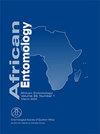Biological Control of Three Eupatorieae Weeds in South Africa: 2011–2020
IF 1.2
4区 农林科学
Q3 ENTOMOLOGY
引用次数: 4
Abstract
Several weed species within the asteraceous tribe Eupatorieae, all with a neotropical origin, are invasive in South Africa. Three of these form the subject of this review paper: Chromolaena odorata (triffid weed), Campuloclinium macrocephalum (pompom weed), and Ageratina adenophora (crofton weed). The three species invade different habitats and regions, and all have biological control (biocontrol) agents established on them. Ageratina adenophora was the first of these weeds to be subjected to a biocontrol programme in South Africa, with two agents (an insect and a pathogen) released and established in the 1980s. Two biocontrol agents were established on C. odorata in the early 2000s, and a third one, first released in 2011, has persisted for at least eight years – all three are insects. One insect biocontrol agent was established on C. macrocephalum in 2013, although a pathogen had appeared on the weed several years earlier. Chromolaena odorata and A. adenophora are under substantial control in certain habitats, but negligible in others. The biocontrol agent on C. macrocephalum released in 2013 is causing significant damage to the plant where it has established well. Several other biocontrol agents have been released on C. odorata but have failed to establish. For all three weedy Eupatorieae, it is considered desirable to establish additional biocontrol agents, so as to increase the level of control of these priority targets in South Africa. An additional biocontrol agent has already been approved for release against C. macrocephalum, while one is close to being approved for C. odorata. There are several possibilities for additional biocontrol agents for A. adenophora.南非三种Eupatorieae杂草的生物防治:2011-2020
紫苑族Eupatorieae中的几种杂草都起源于新热带,它们入侵南非。其中三种构成了这篇综述论文的主题:臭蝴蝶兰(三叶草)、大蓬花(蓬蓬草)和紫茎泽兰(crofton草)。这三个物种入侵不同的栖息地和地区,并且都有生物控制剂。紫茎泽兰是南非第一个接受生物防治计划的杂草,20世纪80年代释放并建立了两种药剂(一种昆虫和一种病原体)。21世纪初,两种生物防治剂被建立在C.odorata身上,第三种于2011年首次发布,已经持续了至少八年——这三种都是昆虫。2013年,一种昆虫生物防治剂被建立在大头草上,尽管几年前就有病原体出现在这种杂草上。臭蝴蝶兰和紫茎紫茎在某些栖息地受到很大的控制,但在其他栖息地可以忽略不计。2013年释放的对C.macronephalum的生物控制剂对其生长良好的植物造成了重大损害。其他几种生物防治剂已被释放到C.odorata身上,但未能确定。对于所有三种杂草Eupatorieae,人们认为最好建立额外的生物防治剂,以提高南非对这些优先目标的控制水平。另外一种生物防治剂已经被批准用于释放对抗大头C.macrochalum,而一种即将被批准用于对付气味C.odorata。有几种可能性可以为紫茎泽兰提供额外的生物防治剂。
本文章由计算机程序翻译,如有差异,请以英文原文为准。
求助全文
约1分钟内获得全文
求助全文
来源期刊

African Entomology
生物-昆虫学
CiteScore
2.00
自引率
0.00%
发文量
17
审稿时长
6-12 weeks
期刊介绍:
African Entomology (ISSN 1021-3589 – print / 2224-8854 – online) replaced the old Journal of the Entomological Society of Southern Africa in 1993. A single volume consisting of two issues (March and September) is published annually. The journal is indexed in all major abstracting journals
African Entomology is a peer reviewed scientific journal that publishes original research articles and short communications on all aspects of entomology, with an emphasis on the advancement of entomology on the African continent.
 求助内容:
求助内容: 应助结果提醒方式:
应助结果提醒方式:


